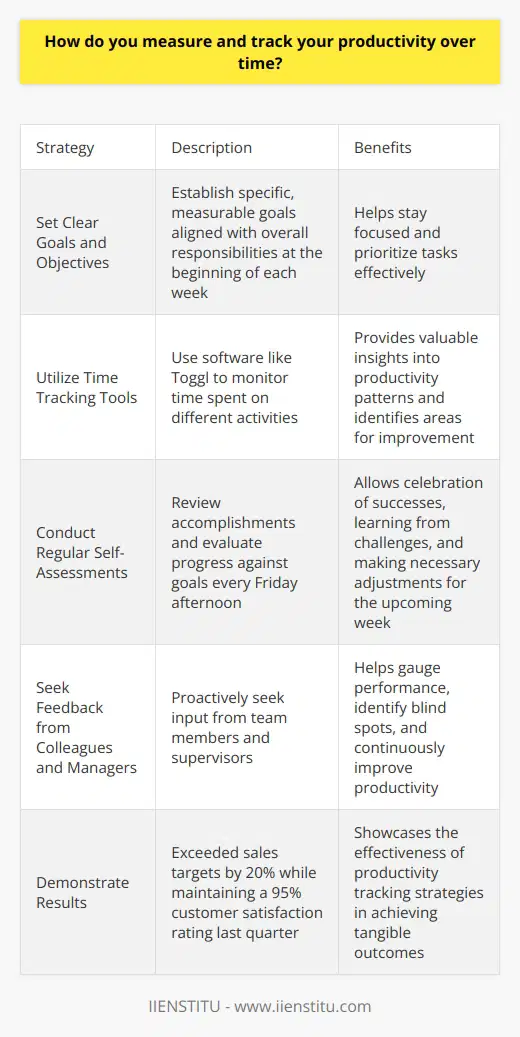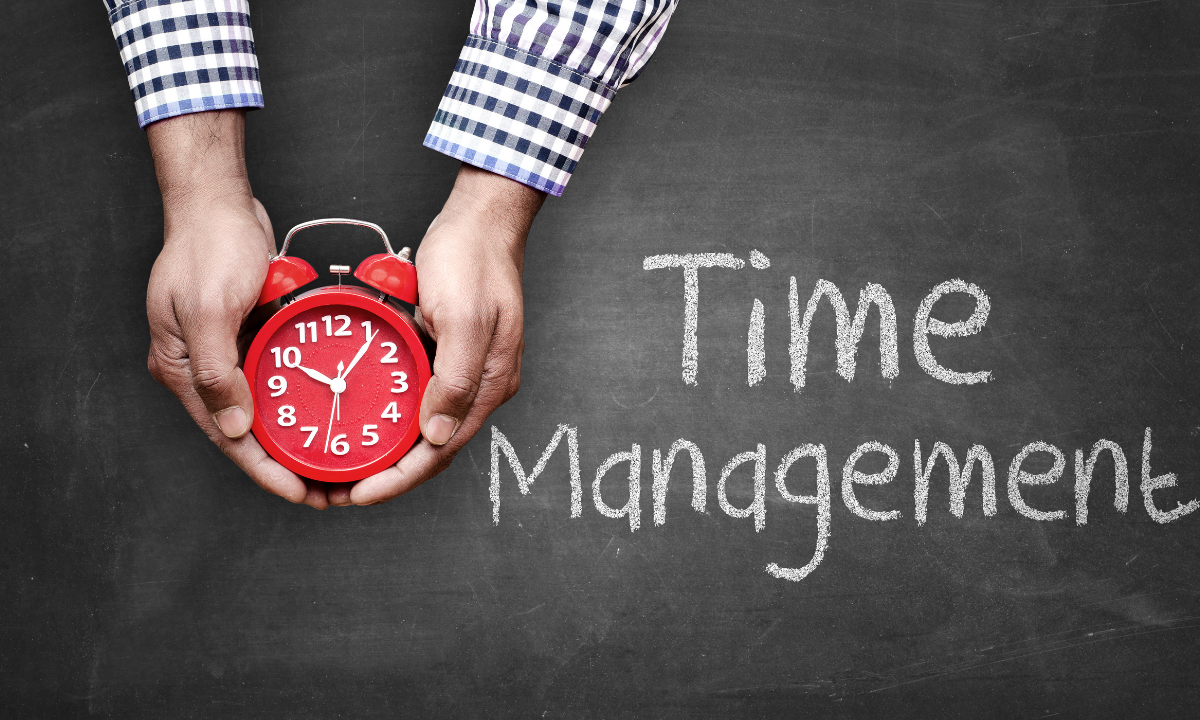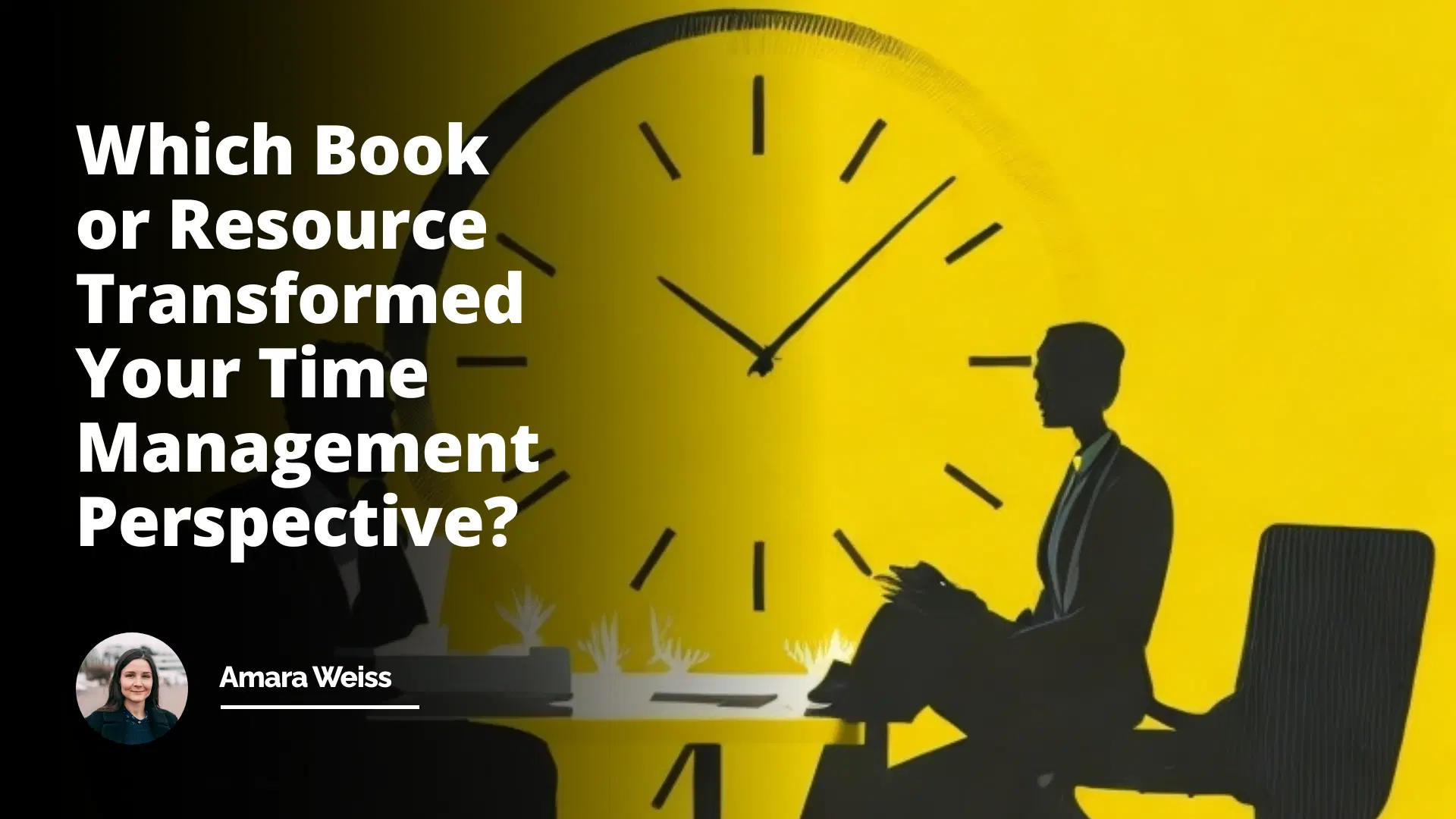
The question, "Which book or resource transformed your time management perspective?" is a classic query in many spheres. But what does it mean, why is it so crucial, and why does it often pop up in interviews? Let's delve in and unravel these knots.
Related Course: Time Management Online Course
Why is "Which Book or Resource Transformed Your Time Management Perspective?" Asked in Interviews?
This question might sound casual and read like a general conversation topic, but make no mistake about it, it's a loaded question aimed at revealing worthwhile insights about you to the interviewer.
When the query, "which book or resource transformed your time management perspective?" is thrown at you, the hiring panel wants to ascertain your commitment to personal development and self-improvement.
Interview Question: Which Time Management Techniques Help Against Procrastination?
Interview Question: What Relaxes You During Stressful Times?
It's a way of peeking into how you invest in yourself, how you approach time management, and whether you believe in continuous learning and growth.
The Purpose of the Question
The focal point of this question centers on how you've grown professionally and personally. Your answer helps the interview panel to gauge whether you have a growth perspective, your willingness to improve, if you're continuously learning, how you adjust to change, and if you have a handle on time management. It also indicates how you may respond to future challenges and modifications in the industry.
At What Interview Level is This Question Asked?
While the question, "which book or resource transformed your time management perspective?" may appear at any interview stage, it is most commonly found at middle to advanced stages of interviews, especially when you're interviewing for managerial or upper-level positions. These roles require personal growth, a strong grasp of time management, and the ability to adapt and learn quickly.
What Kind of Answer is Expected From the Candidate?
A thorough, insightful response to this question could significantly elevate your candidacy. Interviewers are more interested in the 'why' part than the 'what' part of your answer. Anyone can mention a book or a course.
They're more interested in what you learned, how it transformed your perspective on time management, and how it impacted your professional life.
Possible Answers to Consider
Before you get down to answering, do your research on what the company values. This helps frame your response in a way that shows alignment with the organization's ethos.
For instance, if the company emphasizes continuous learning, you might say,
"The 7 Habits of Highly Effective People by Stephen Covey was a game-changer for me. It made me realize that being effective is about prioritizing and focusing on the most impactful tasks. Since reading it, I've improved my ability to discern 'urgent' tasks from 'important' ones, which has greatly enhanced my productivity."
The query, "which book or resource transformed your time management perspective?" is more than a mere conversational topic.
It delves into your personal development, adaptability, and time management skills. By providing a thoughtful and well-structured response, you illustrate your commitment to continuous learning, which is paramount in today's dynamic job landscape.
Remember, the magic lies in the transformation part of your answer, not just the name of the book or the resource.
Books That Influenced Time Management Skills
Key Insights: Interview Question: Which Book or Resource Transformed Your Time Management Perspective?
Resources That Significantly Affected Perception of Time Management
Similar interview questions:
Can you recall any books or resources that profoundly changed your outlook on time management?
Is there a particular book or resource that triggered a change in how you manage your time?
Do you remember a specific book or resource that had a significant impact on your viewpoint of time management?
What particular book or resource caused a paradigm shift in your perspective of time management?
Is there any book or resource that revolutionized your thought process about time management?
Were there any resources or books that dramatically influenced your approach to managing your time?
Was there a book or resource that altered your perception about time management?
Which literature or information source made a transformational change to your time management approach?
Can you name a single book or resource which drastically reshaped your perspective on time management?
What resource or book resulted in a dramatic shift in your time management perspective?
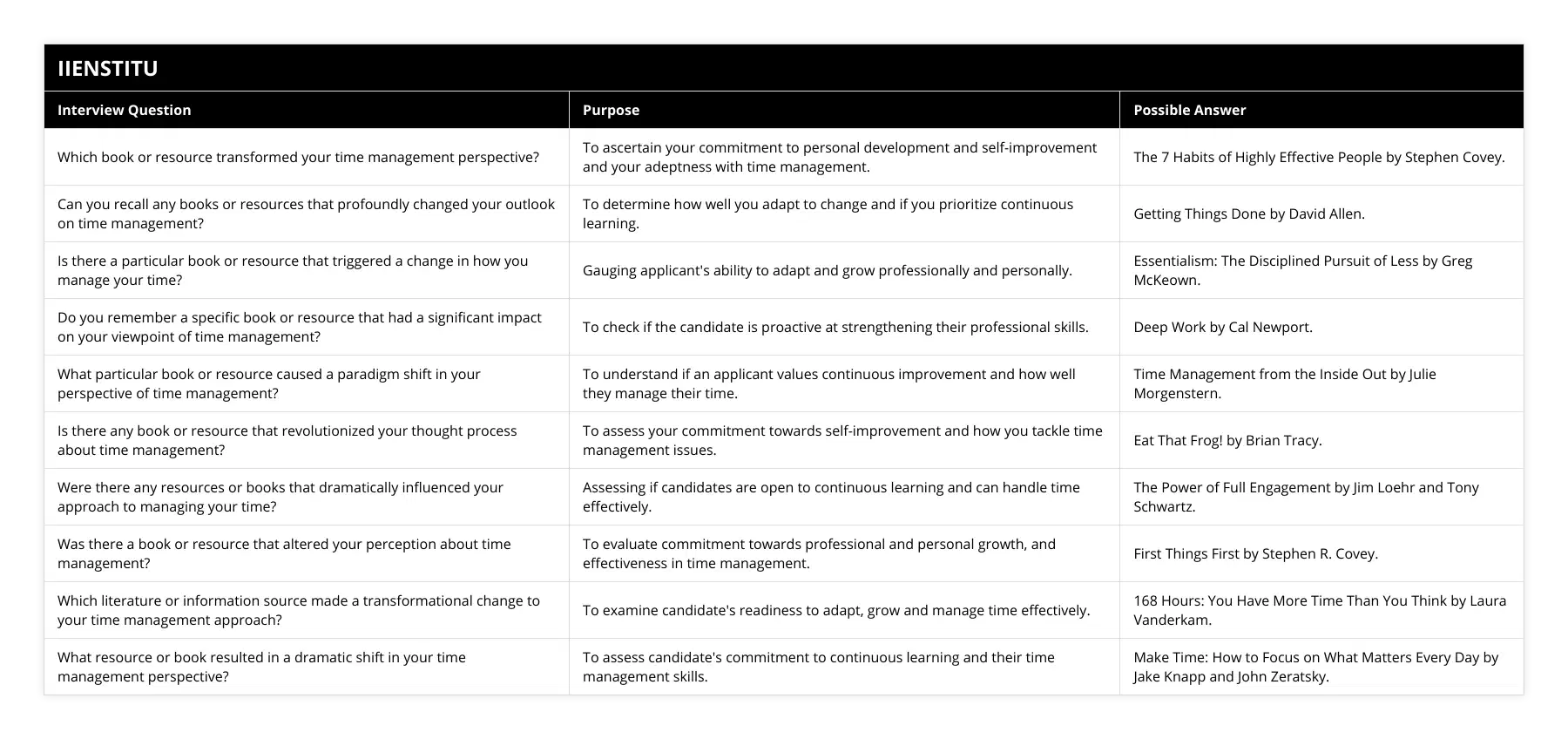
Frequently Asked Questions
Which productivity-boosting technique had the biggest impact on your work?
The productivity-boosting technique that had the biggest impact on my work was the Pomodoro Technique. I discovered this simple yet effective method a few years ago, and it completely transformed the way I approach my tasks.
How the Pomodoro Technique Works
The basic idea is to break your work into focused, 25-minute intervals called "pomodoros." After each pomodoro, you take a short break of about 5 minutes to recharge. Every four pomodoros, you take a longer break of 15-30 minutes.
Why It Works for Me
I found that by working in these short bursts, I could maintain my concentration and avoid burnout. The regular breaks helped me stay fresh and prevented me from getting bogged down in a task.
Moreover, the technique gave me a sense of urgency and helped me stay on track. Knowing that I only had 25 minutes to make progress before the next break kept me focused and motivated.
Adapting the Technique to My Needs
Over time, I tweaked the Pomodoro Technique to suit my personal work style. I adjusted the length of the intervals and breaks based on the nature of the task and my energy levels.
For example, when working on a particularly challenging project, I might extend the pomodoro to 45 minutes. For lighter tasks, I might shorten it to 15 minutes.
The Impact on My Productivity
Since adopting the Pomodoro Technique, I've noticed a significant boost in my productivity. I'm able to get more done in less time, without sacrificing the quality of my work.
It's also helped me develop better work habits and a more balanced approach to my day. I no longer feel overwhelmed by my to-do list, because I know I can tackle it one pomodoro at a time.
In short, the Pomodoro Technique has been a game-changer for me. It's a simple, flexible tool that anyone can use to improve their focus and get more done.
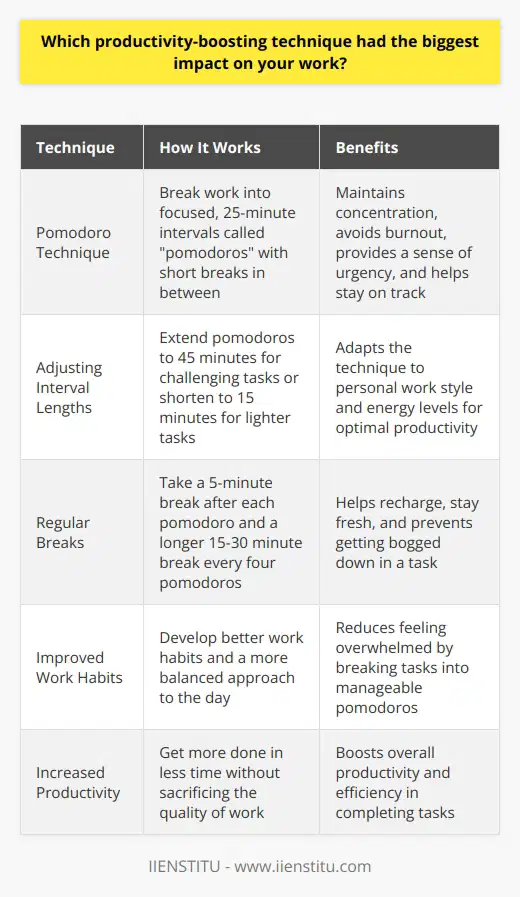
How do you prioritize tasks effectively?
Effective Task Prioritization
When faced with multiple tasks, I always start by making a list and assessing the importance and urgency of each item. I consider factors such as deadlines, potential impact, and dependencies to determine which tasks require immediate attention. For example, when I was working on a project with a tight deadline last year, I prioritized the critical tasks that were essential for meeting the timeline and delegated non-essential tasks to other team members.
Breaking Down Complex Tasks
For complex tasks, I break them down into smaller, manageable steps. This approach helps me stay focused and avoids overwhelming feelings. I create a timeline for each subtask and set milestones to track my progress. By tackling the project piece by piece, I can ensure that I'm making steady progress towards the final goal.
Flexibility and Adaptability
I understand that priorities can change unexpectedly, so I remain flexible and adaptable. I regularly reassess my priorities and make adjustments as needed. If a new urgent task arises, I quickly re-evaluate my list and make necessary changes to accommodate the new priority.
Communication and Collaboration
Effective communication and collaboration with team members are crucial for successful task prioritization. I keep my colleagues informed about my progress and any potential roadblocks. By maintaining open lines of communication, we can work together to address challenges and ensure that everyone is aligned on priorities.
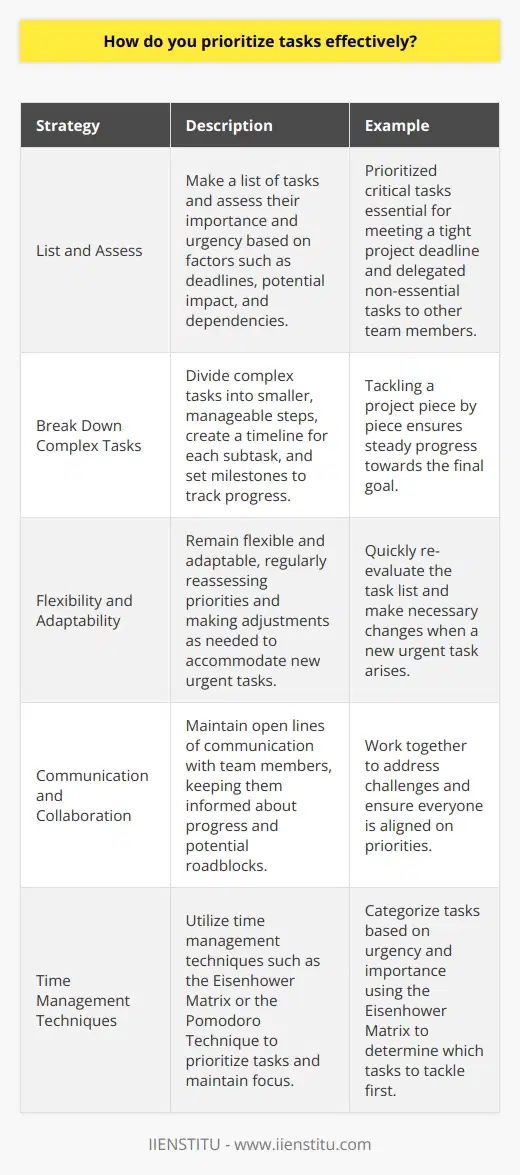
What's your strategy for dealing with distractions and staying focused?
When it comes to dealing with distractions and staying focused, I have a few strategies that have proven effective for me. First and foremost, I prioritize my tasks and create a daily to-do list to keep myself on track. This helps me stay organized and ensures that I'm always working on the most important things.
Minimizing Distractions
To minimize distractions, I try to create a quiet and clutter-free workspace. I close unnecessary browser tabs, silence my phone notifications, and let my colleagues know when I need uninterrupted focus time. If I'm working on a particularly challenging task, I might even put on noise-canceling headphones to block out any external noise.
Taking Breaks
I've also found that taking regular breaks is crucial for maintaining my focus. Every hour or so, I step away from my desk, stretch my legs, and give my mind a chance to reset. This helps me avoid burnout and keeps me fresh and alert throughout the day.
Staying Motivated
Finally, I try to stay motivated by reminding myself of my long-term goals and the importance of the work I'm doing. When I feel my focus starting to slip, I take a moment to visualize the end result and the impact it will have. This helps me push through any temporary distractions and stay committed to the task at hand.
Of course, everyone is different, and what works for me might not work for everyone. But by experimenting with different strategies and finding what works best for you, I believe anyone can learn to manage distractions and stay focused on their goals.
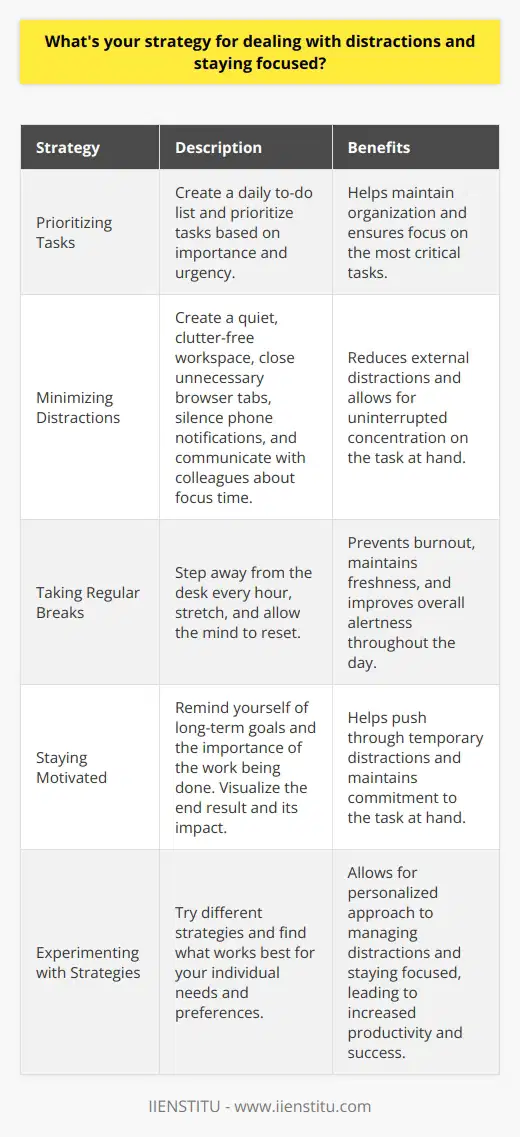
How do you balance short-term tasks with long-term goals?
I balance short-term tasks with long-term goals by prioritizing my daily responsibilities while keeping the big picture in mind. Each morning, I review my to-do list and identify the most critical tasks that align with my long-term objectives. This helps me stay focused and avoid getting sidetracked by less important activities.
Effective Time Management
I'm a strong believer in effective time management. I break down my long-term goals into smaller, manageable milestones and allocate specific time slots for working on them. This approach allows me to make steady progress without neglecting my day-to-day responsibilities.
Staying Flexible
However, I also understand the importance of staying flexible. Sometimes unexpected challenges or opportunities arise, and I need to adapt my plans accordingly. When this happens, I take a step back, reassess my priorities, and make adjustments to ensure I'm still moving towards my long-term goals.
Continuous Learning and Growth
Another key aspect of balancing short-term tasks with long-term goals is continuous learning and growth. I'm always looking for ways to improve my skills and knowledge, whether through online courses, attending workshops, or seeking feedback from colleagues. By investing in my personal and professional development, I'm better equipped to handle both immediate challenges and future aspirations.
Ultimately, balancing short-term tasks with long-term goals is about being intentional with my time and energy. It requires discipline, adaptability, and a clear sense of purpose. By staying focused on what matters most, I'm able to make meaningful progress and achieve success in both the short and long term.
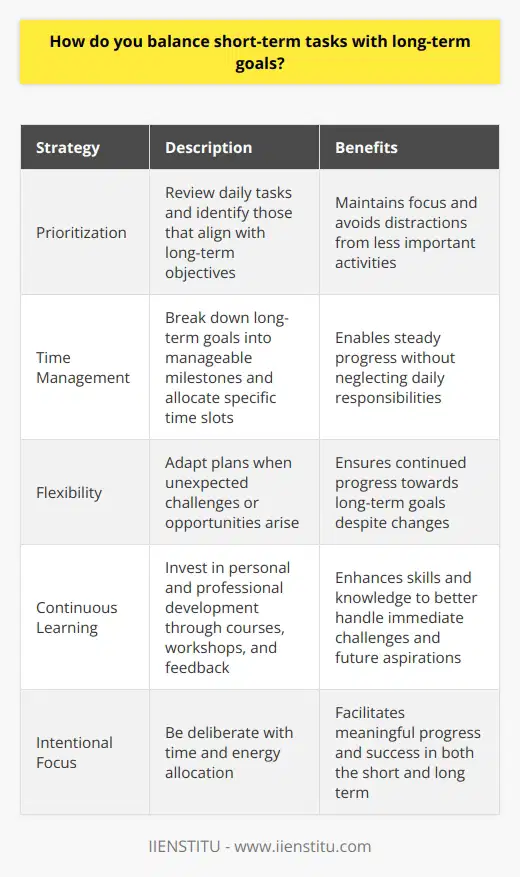
What's your approach to managing your energy levels throughout the day?
I believe in maintaining a consistent energy level throughout the day to maximize productivity and well-being. Here are some strategies I use:
Prioritizing Sleep
Getting enough quality sleep is essential for me. I aim for 7-8 hours each night and stick to a regular sleep schedule, even on weekends. Feeling well-rested helps me start the day with energy and focus.
Balanced Nutrition
What I eat plays a big role in my energy levels. I focus on whole, unprocessed foods and include plenty of fruits, vegetables, lean proteins, and complex carbs. Staying hydrated by drinking water throughout the day is also key.
Regular Movement
I've found that incorporating physical activity into my routine helps boost and sustain my energy. I enjoy going for a brisk walk during my lunch break or doing some stretches at my desk. The movement and fresh air are revitalizing.
Managing Stress
Chronic stress can be incredibly draining. When I feel overwhelmed, I take a few minutes to practice deep breathing or meditation. These mindfulness techniques help me recenter and approach tasks with renewed energy.
Taking Breaks
I've learned that powering through without breaks is counterproductive. I schedule short breaks throughout the day to step away from my work and recharge. Whether it's chatting with a colleague or sipping a cup of tea, these moments help me maintain my stamina.
By prioritizing these self-care practices, I'm able to effectively manage my energy levels and bring my best self to my work each day.
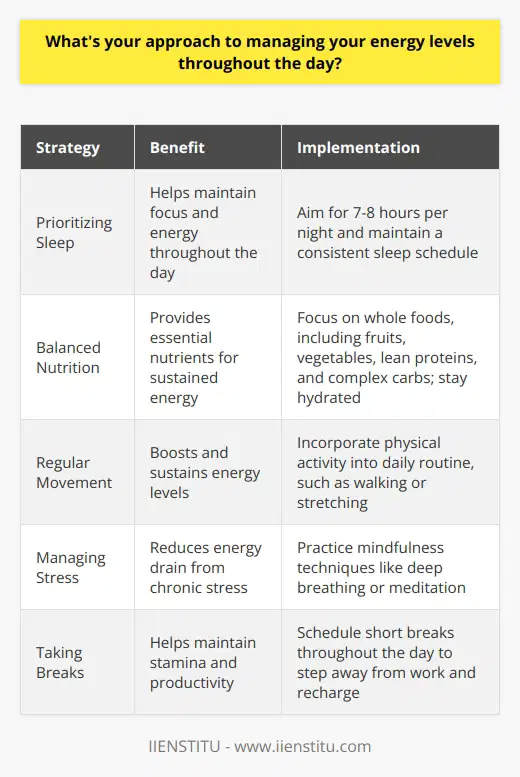
How do you handle unexpected interruptions or emergencies?
I handle unexpected interruptions and emergencies by staying calm and focused. I quickly assess the situation and prioritize tasks based on urgency and importance.
Communicate and Delegate
Clear communication is key. I inform my team about the issue and delegate tasks to address it efficiently. Collaboration helps resolve problems faster.
Adapt and Be Flexible
Emergencies often require adjusting plans. I remain flexible, open to new approaches, and ready to adapt my workflow. Rigid thinking only hinders progress.
Learn and Improve
After the emergency passes, I reflect on how it was handled. What went well? What could be improved? I apply these lessons to strengthen my problem-solving skills for the future.
Stay Positive
Throughout unexpected challenges, I maintain a positive attitude. Getting stressed or frustrated is counterproductive. I focus my energy on finding solutions and moving forward.
In my previous role, a critical system went down right before a major product launch. I quickly gathered the team, assessed the problem, and we worked together to resolve it. We communicated status updates to stakeholders and adjusted launch plans as needed. In the end, we successfully released only one day later than originally scheduled. I learned the importance of staying levelheaded, collaborating closely, and being flexible with timelines. These lessons have served me well in navigating other unexpected situations since then.
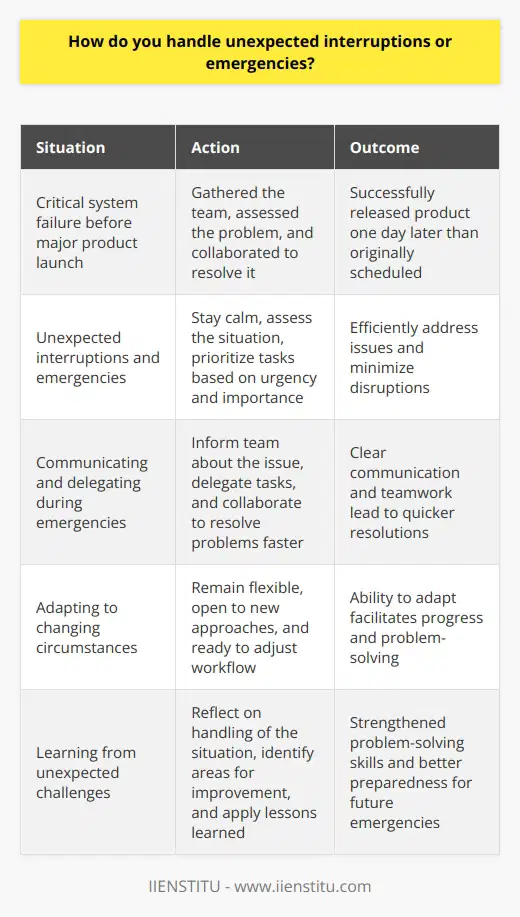
What's your system for tracking progress and meeting deadlines?
I use a combination of digital tools and old-fashioned pen and paper to track my progress and meet deadlines. Here's my system:
Digital Calendar
I rely heavily on my digital calendar to keep track of important dates and deadlines. I set reminders for myself well in advance, so I have plenty of time to prepare.
Project Management Software
For complex projects with multiple tasks and subtasks, I use project management software like Trello or Asana. These tools help me break down big goals into smaller, manageable steps and track my progress along the way.
Daily To-Do Lists
Every morning, I make a to-do list for the day ahead. I prioritize tasks based on urgency and importance, tackling the most critical items first. Crossing things off my list gives me a sense of accomplishment and keeps me motivated.
Regular Check-Ins
I schedule regular check-ins with myself and my team to assess progress and identify any obstacles or roadblocks. These meetings help keep everyone accountable and on track.
Pen and Paper
Sometimes, nothing beats the simplicity of pen and paper. I always carry a notebook with me to jot down ideas, reminders, and notes from meetings. There's something satisfying about physically crossing items off a list!
By using a combination of digital tools and analog methods, I'm able to stay organized, prioritize effectively, and meet deadlines consistently. It's a system that has served me well throughout my career.
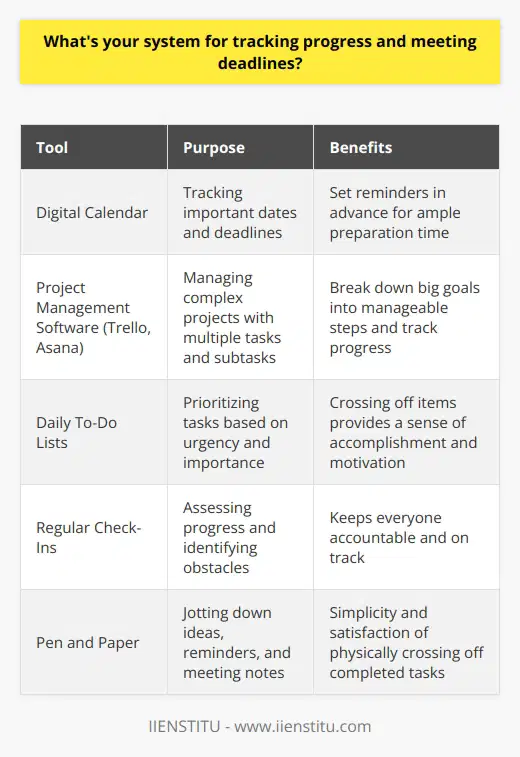
How do you delegate tasks and manage your team's workload?
When delegating tasks and managing my team's workload, I focus on clear communication and playing to everyone's strengths. I start by breaking down projects into smaller, manageable tasks and setting realistic deadlines. This helps prevent overwhelm and ensures steady progress.
Matching Tasks to Skills and Interests
I take the time to understand each team member's unique skills, experience, and interests. Whenever possible, I assign tasks that align with their strengths and aspirations. This not only leads to better results, but it also boosts motivation and job satisfaction. People tend to put more effort into work they find engaging.
Providing Guidance and Support
While I trust my team to handle their responsibilities, I make sure to provide the necessary resources and guidance. I'm always available to answer questions, offer feedback, or lend a hand if someone gets stuck. Regular check-ins help me stay informed about progress and potential roadblocks.
Encouraging Collaboration and Initiative
I believe in fostering a collaborative environment where team members feel comfortable sharing ideas and taking initiative. I encourage open communication and value everyone's input. When people feel heard and empowered, they're more likely to go the extra mile and come up with creative solutions.
At the end of the day, effective delegation is about trust, communication, and playing to your team's strengths. By breaking down tasks, providing support, and encouraging collaboration, I strive to keep projects running smoothly while enabling my team to grow and succeed.

What's your method for breaking down complex projects into manageable steps?
When tackling complex projects, I first identify the end goal and work backwards to determine the necessary steps. Breaking the project into smaller, manageable tasks helps me stay focused and motivated throughout the process.
Prioritizing Tasks
I prioritize tasks based on their importance and dependencies. Critical tasks that impact other aspects of the project take precedence. This ensures a smooth workflow and prevents bottlenecks from occurring along the way.
Setting Milestones
Setting milestones at key points in the project helps me track progress and make adjustments as needed. Celebrating these small wins keeps the team motivated and focused on the ultimate goal.
Collaborating with the Team
Collaboration is key to success. I work closely with my team, leveraging each member's strengths and expertise. Regular check-ins ensure everyone is aligned and working towards the same objectives.
Adapting to Change
Complex projects often encounter unexpected challenges. I remain flexible and adapt my approach when necessary. By staying agile, I can quickly address issues and keep the project moving forward.
In my previous role, I successfully led a cross-functional team in implementing a new CRM system. By breaking the project into manageable steps, setting clear milestones, and fostering collaboration, we delivered the project on time and within budget. This experience taught me the importance of effective project management and the value of a dedicated team.
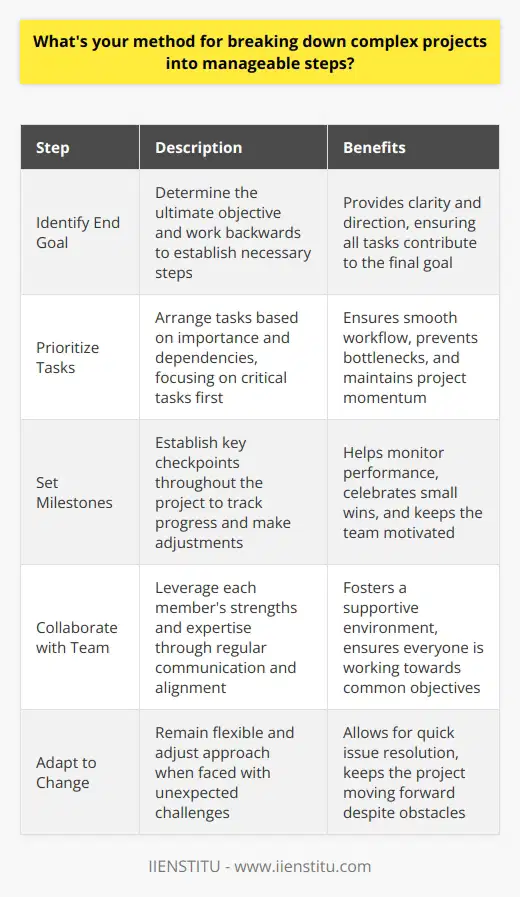
How do you ensure effective communication and collaboration with your team?
As an experienced team leader, I understand the importance of effective communication and collaboration. Here are some strategies I employ to ensure seamless teamwork:
Establish Clear Channels
I set up regular team meetings, both in-person and virtual, to discuss projects, goals, and challenges. Additionally, I utilize collaboration tools like Slack and Asana to keep everyone connected and informed.
Encourage Open Dialogue
I foster an environment where team members feel comfortable sharing their ideas, concerns, and feedback. When I first joined my previous company, I implemented an open-door policy that significantly improved team morale and productivity.
Practice Active Listening
During discussions, I make a conscious effort to listen attentively to each team member's perspective. I ask clarifying questions and summarize key points to ensure mutual understanding.
Provide Constructive Feedback
I believe in giving timely, specific, and actionable feedback to help team members grow and improve. I once helped a struggling colleague improve their presentation skills through personalized coaching sessions.
Lead by Example
I strive to model the communication and collaboration behaviors I expect from my team. I maintain transparency, follow through on commitments, and acknowledge my own mistakes when necessary.
By implementing these strategies consistently, I've successfully led cross-functional teams to achieve ambitious goals while maintaining a positive and collaborative work culture.

What's your secret to maintaining a healthy work-life balance?
Maintaining a healthy work-life balance is crucial for both personal well-being and professional success. Over the years, I've developed a few strategies that help me strike this delicate balance.
Setting Clear Boundaries
I firmly believe in setting clear boundaries between work and personal life. When I'm at work, I focus fully on my professional responsibilities. However, once I leave the office, I make a conscious effort to disconnect from work-related matters and dedicate time to my personal life.
Prioritizing Self-Care
Self-care is a non-negotiable aspect of my routine. I make sure to allocate time for activities that help me recharge and relax, such as regular exercise, pursuing hobbies, and spending quality time with loved ones. Taking care of my physical and mental health enables me to perform better at work.
Effective Time Management
I'm a strong believer in effective time management. I prioritize tasks, create to-do lists, and use productivity tools to ensure that I'm making the most of my time at work. This allows me to accomplish my goals efficiently, leaving more time for personal pursuits outside of work hours.
Communicating Openly
Open communication is key to maintaining a healthy work-life balance. I actively communicate my needs and expectations to my colleagues and superiors. If I have personal commitments that require flexibility, I discuss them transparently to find mutually beneficial solutions.
Embracing Flexibility
In today's fast-paced world, flexibility is essential. I embrace remote work options and flexible schedules when possible. This allows me to better integrate my work and personal responsibilities, reducing stress and increasing overall satisfaction.
Ultimately, achieving a healthy work-life balance is an ongoing process that requires conscious effort and adaptability. By setting boundaries, prioritizing self-care, managing time effectively, communicating openly, and embracing flexibility, I strive to maintain a harmonious balance between my professional and personal life.
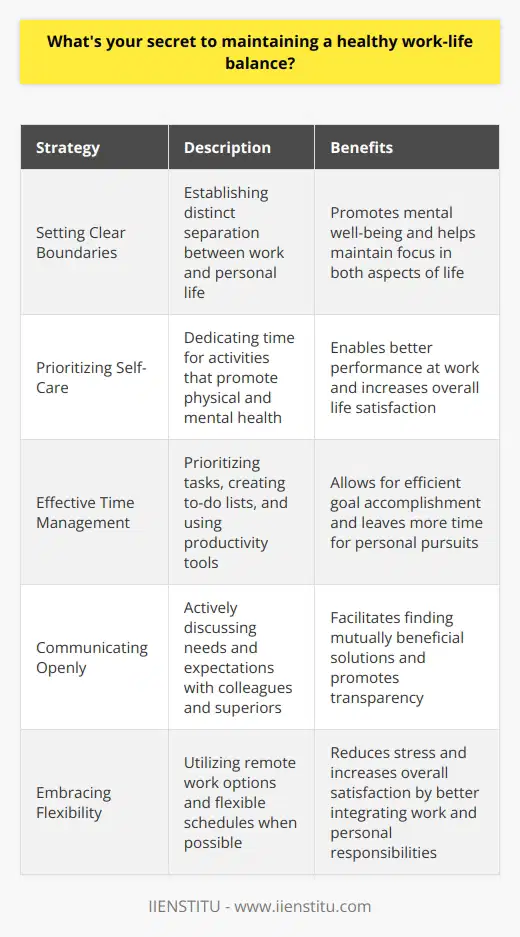
How do you continuously improve your time management skills?
I continuously improve my time management skills through a combination of self-reflection, learning, and practice. Whenever I complete a project or task, I take a moment to assess how well I managed my time and identify areas for improvement. Did I accurately estimate the time required? Did I prioritize effectively? Was I able to minimize distractions?
Seeking Out New Strategies
I'm always on the lookout for new time management techniques and tools. I enjoy reading books and articles on productivity, attending workshops, and learning from colleagues who excel at managing their time. By exposing myself to fresh ideas, I'm able to experiment with different approaches and find what works best for me.
Practicing Consistently
Of course, knowledge alone isn't enough - I have to put what I learn into practice. I challenge myself to implement new strategies in my daily work, even if it feels uncomfortable at first. Over time, through consistent effort, these new habits become second nature.
Adjusting to Change
As my responsibilities and circumstances evolve, so too must my time management approach. What worked for me in a previous role or project might not be as effective in a new context. I try to stay flexible and adapt my techniques as needed.
Focusing on Progress, Not Perfection
I've learned that improving my time management skills is an ongoing journey, not a destination. There will always be room for growth and refinement. Instead of striving for perfection, I focus on making steady progress and celebrating the small wins along the way.
By continuously reflecting, learning, practicing, and adjusting, I'm able to incrementally improve my time management capabilities over time. It's a lifelong process, but one that yields immense benefits in both my professional and personal life.

What's your approach to managing stress and avoiding burnout?
I believe that managing stress and avoiding burnout is all about finding the right balance. For me, it starts with setting clear boundaries between work and personal life. When I'm at work, I give my full focus and energy to my tasks, but when the workday is over, I make a conscious effort to disconnect and recharge.
Prioritizing Self-Care
I've learned that taking care of myself is essential for managing stress. I make sure to get enough sleep, eat well, and exercise regularly. When I feel overwhelmed, I take short breaks to practice deep breathing or go for a quick walk to clear my head. These simple acts of self-care help me maintain a positive outlook and keep stress at bay.
Staying Organized
Another key aspect of my stress management approach is staying organized. I use tools like calendars, to-do lists, and project management software to keep track of my tasks and deadlines. By breaking down large projects into smaller, manageable steps, I avoid feeling overwhelmed and maintain a sense of control over my workload.
Communicating Openly
When stress levels start to rise, I believe in communicating openly with my colleagues and supervisors. If I'm feeling overloaded or need help prioritizing tasks, I don't hesitate to reach out and ask for support. By fostering a culture of open communication and collaboration, we can work together to find solutions and prevent burnout.
Maintaining Work-Life Balance
Finally, I make a point of maintaining a healthy work-life balance. I set aside time for hobbies, spending time with loved ones, and pursuing personal interests outside of work. By nurturing these other aspects of my life, I'm able to recharge my batteries and return to work with renewed energy and focus.
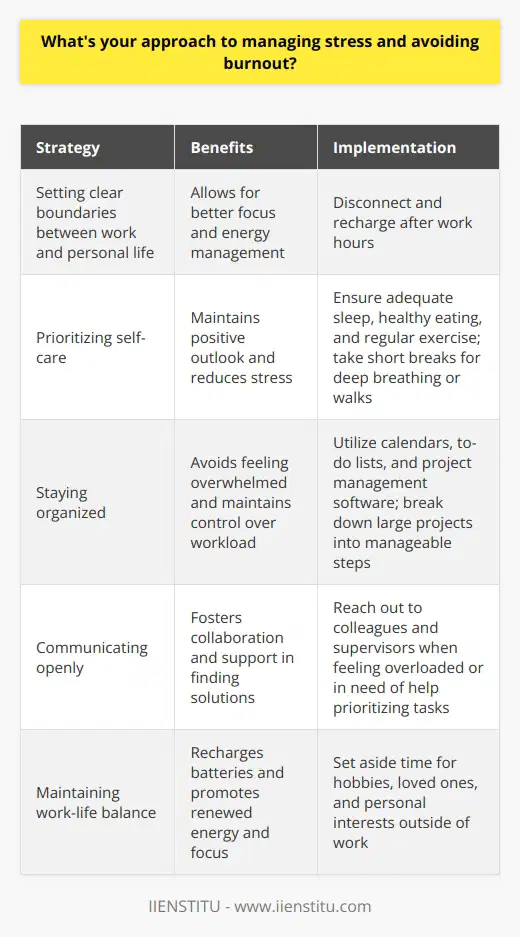
How do you handle procrastination and stay motivated?
I tackle procrastination head-on by breaking down large tasks into smaller, manageable steps. This helps me stay focused and motivated. I set realistic goals for each day and hold myself accountable to them.
Prioritizing Tasks
I prioritize my tasks based on importance and urgency. This ensures that I'm always working on the most critical projects first. I use tools like calendars and to-do lists to stay organized and on track.
Minimizing Distractions
I minimize distractions by creating a focused work environment. I silence my phone, close unnecessary browser tabs, and find a quiet space to work. Taking regular breaks helps me recharge and maintain my motivation throughout the day.
Leveraging Accountability
I've found that having an accountability partner can be incredibly effective for staying motivated. Whether it's a colleague or a friend, having someone to check in with regularly helps me stay committed to my goals. We share our progress, celebrate successes, and encourage each other through challenges.
Finding Inspiration
When I feel my motivation waning, I seek out inspiration. I read articles or listen to podcasts related to my field, attend conferences or webinars, and connect with mentors who can offer guidance and support. Continuously learning and growing helps me stay engaged and excited about my work.
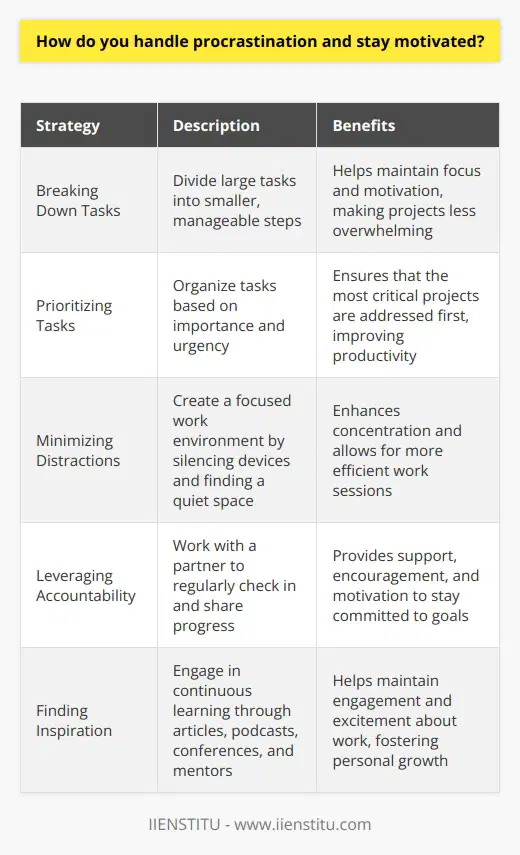
What's your strategy for managing emails and other forms of communication?
My strategy for managing emails and other forms of communication is all about prioritization and organization. I've found that it's crucial to have a system in place to keep track of important messages and ensure nothing falls through the cracks.
Prioritizing Emails
When it comes to emails, I start by quickly scanning through my inbox and flagging any messages that require immediate attention. This helps me tackle the most pressing issues first. I also make use of email folders and labels to categorize messages based on their urgency and relevance.
Setting Aside Dedicated Time
I've learned that constantly checking emails throughout the day can be a major productivity killer. Instead, I set aside dedicated blocks of time to focus solely on responding to emails and other communications. This allows me to give each message the attention it deserves without getting distracted by other tasks.
Leveraging Communication Tools
In addition to email, I'm a big believer in using various communication tools to streamline collaboration and keep everyone on the same page. Whether it's instant messaging platforms like Slack or project management tools like Trello, I find that these tools help me stay organized and communicate more effectively with my team.
Being Clear and Concise
When crafting emails or other messages, I always aim to be clear and concise. I try to keep my messages focused on the key points and action items, making it easy for the recipient to understand what's needed from them. This helps reduce back-and-forth communication and keeps projects moving forward smoothly.
Regular Follow-Up and Follow-Through
Finally, I make it a point to regularly follow up on important communications and ensure that any action items are being addressed in a timely manner. I've found that a little proactive follow-up can go a long way in keeping projects on track and ensuring nothing gets overlooked.
By implementing these strategies, I've been able to effectively manage my email and communication workload, even during busy periods. It's all about finding a system that works for you and being disciplined in sticking to it.

How do you prioritize self-care and personal development?
I believe that prioritizing self-care and personal development is essential for overall well-being and success. I make sure to set aside time each day for activities that nourish my mind, body, and soul.
Maintaining Physical Health
Staying physically active is a key component of my self-care routine. I enjoy going for morning jogs and attending yoga classes at my local gym. These activities help me feel energized, reduce stress, and improve my focus throughout the day.
Nurturing Mental Well-being
To support my mental health, I practice mindfulness and meditation. Taking a few minutes each day to sit quietly and focus on my breath helps me stay grounded and centered. I also make it a priority to connect with loved ones and engage in hobbies that bring me joy, like painting and playing the guitar.
Investing in Personal Growth
I'm a firm believer in lifelong learning and personal development. I regularly attend workshops and seminars related to my field of work. This helps me stay up-to-date with industry trends and acquire new skills. I also enjoy reading self-improvement books and listening to podcasts that inspire me to grow both personally and professionally.
By making self-care and personal development a priority, I'm able to show up as my best self in all areas of life, including my career. It's not always easy to find the time, but I've learned that investing in myself is one of the most valuable things I can do.

What's your method for making the most of your downtime and breaks?
I believe in using my downtime and breaks to recharge and refocus. During my lunch break, I often take a short walk outside to get some fresh air and clear my mind. This helps me come back to work with renewed energy and a fresh perspective.
Maximizing Productivity During Breaks
I also use my breaks to tackle personal tasks like responding to important emails or messages. By getting these small tasks out of the way, I can minimize distractions and stay focused when I'm back at work.
Learning and Growth Opportunities
Whenever possible, I use my downtime to learn something new related to my job or industry. I might read an article, watch a short tutorial video, or even have a quick conversation with a colleague about a project they're working on. I find that these brief learning opportunities help me stay engaged and motivated throughout the day.
Balancing Relaxation and Productivity
Of course, I also understand the importance of true relaxation during breaks. Sometimes, the best way to make the most of my downtime is to simply disconnect and do something I enjoy, like reading a book or listening to music. By giving myself permission to truly step away from work, even for just a few minutes, I find that I'm able to approach my tasks with greater focus and creativity when I return.
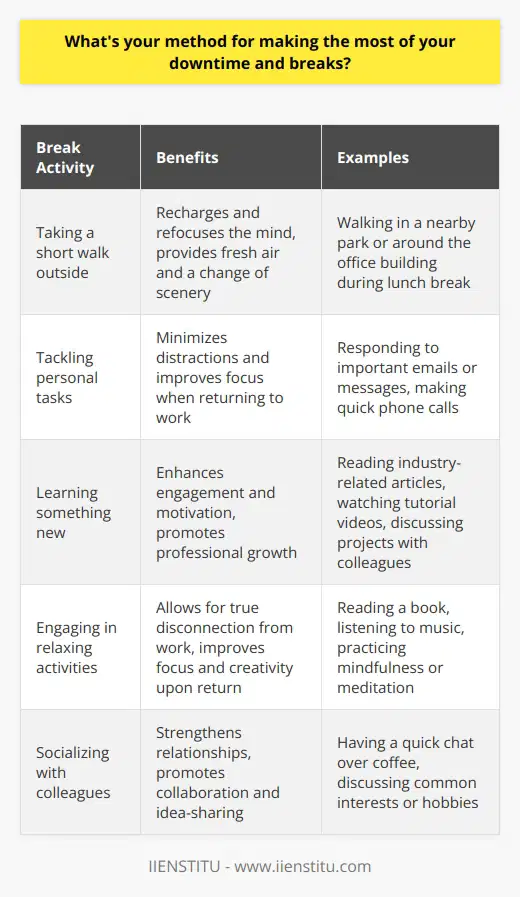
How do you adapt your time management strategies to different work environments?
I adapt my time management strategies to different work environments by first assessing the unique challenges and priorities of each situation. This involves understanding the specific goals, deadlines, and resources available in that particular setting.
Prioritizing Tasks
Once I have a clear understanding of the environment, I prioritize tasks based on their importance and urgency. I focus on the most critical and time-sensitive tasks first, ensuring that I allocate my time and energy effectively.
Example from Personal Experience
In my previous role as a project manager, I encountered a fast-paced startup environment where priorities often shifted rapidly. To adapt, I implemented a daily stand-up meeting with my team to quickly reassess priorities and adjust our time management plan accordingly. This agile approach allowed us to stay flexible and responsive to changing demands.
Utilizing Tools and Techniques
I also leverage various tools and techniques to optimize my time management in different work environments. For instance, I use project management software to create detailed timelines, set reminders, and track progress. Additionally, I employ techniques like the Pomodoro Technique, which involves working in focused intervals with short breaks in between, to maintain productivity and avoid burnout.
Collaborating and Communicating
Effective collaboration and communication are key to successful time management in any work environment. I actively seek input from colleagues and stakeholders to ensure alignment and identify potential roadblocks early on. Regular check-ins and status updates help keep everyone on the same page and prevent unnecessary delays.
Personal Reflection
Adapting my time management strategies to different work environments has been a continuous learning process for me. It requires flexibility, proactivity, and a willingness to experiment with new approaches. Over time, I've developed a toolkit of strategies that I can draw upon depending on the specific demands of each situation.
Ultimately, the key to effective time management lies in staying organized, communicating clearly, and remaining adaptable to change. By tailoring my approach to the unique needs of each work environment, I can consistently deliver results and maintain a healthy work-life balance.
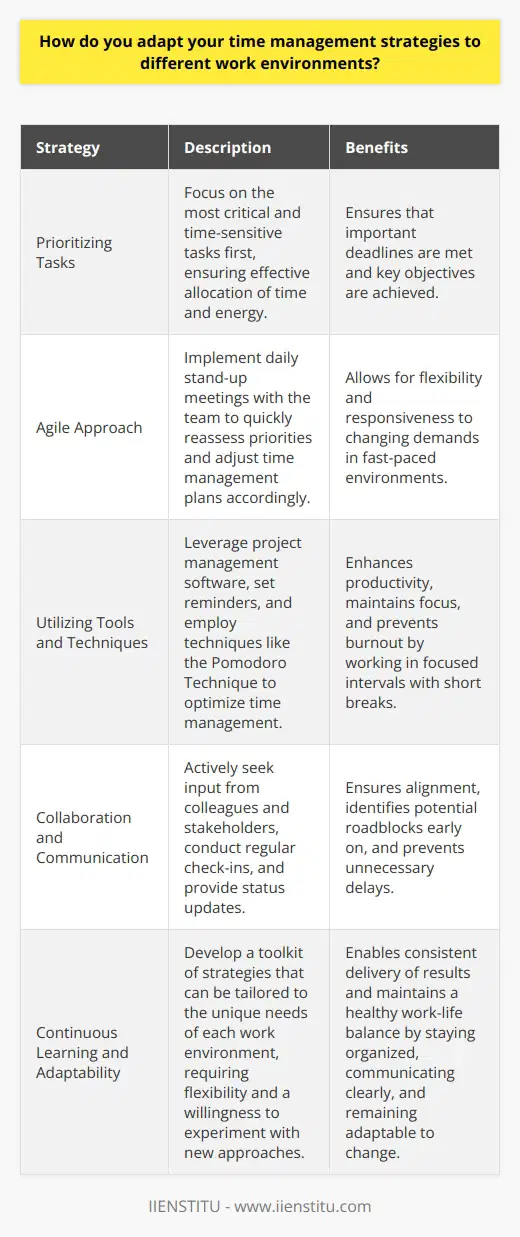
What's your approach to managing remote work and virtual collaboration?
As a remote worker for several years, I've developed effective strategies for managing virtual collaboration. Communication is key, so I prioritize regular check-ins with my team through video calls and instant messaging. This keeps everyone aligned on goals and progress.
Leveraging Technology
I'm a firm believer in using the right tools for the job. Project management software like Asana helps me track deadlines and deliverables. For brainstorming sessions, virtual whiteboards such as Miro are invaluable to capture ideas visually.
Building Trust and Rapport
Working remotely requires a foundation of trust. I strive to be reliable and transparent with my availability and workload. Informal virtual coffee chats help build camaraderie too - it's important to connect as humans, not just colleagues!
Embracing Flexibility
One advantage of remote work is greater flexibility. I've found that accommodating different schedules and working styles boosts productivity. As long as we communicate clearly about expectations and deadlines, a little flexibility goes a long way.
At the end of the day, successful remote collaboration comes down to intentionality. With the right mindset, tools, and practices, virtual teams can thrive. I'm excited to bring my experience to this role and help drive results, no matter where we're located.
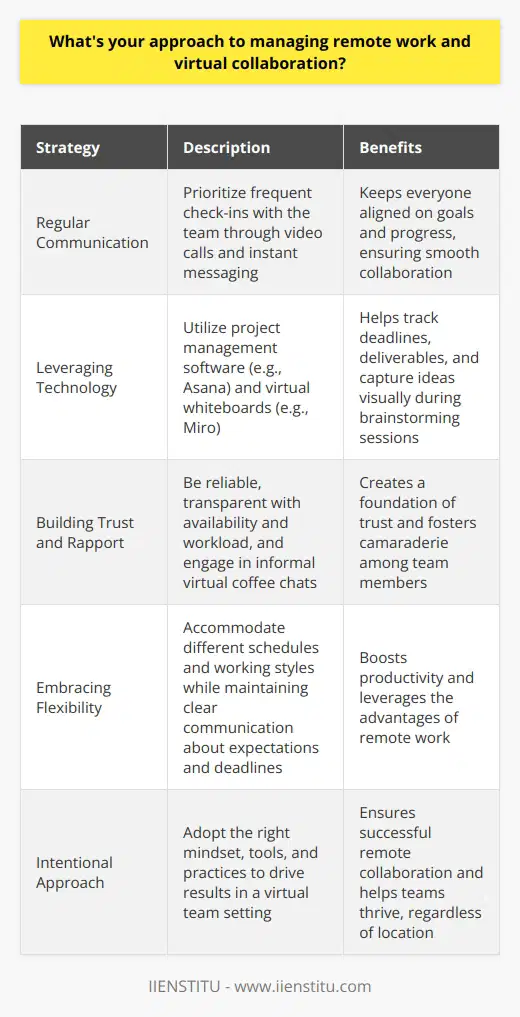
How do you handle multiple projects and competing priorities?
I am skilled at handling multiple projects and competing priorities. Throughout my career, I have developed effective strategies for managing my workload and meeting deadlines.
Prioritization is Key
I prioritize tasks based on importance and urgency. I assess each project's impact on company goals and allocate my time accordingly. This helps me focus on the most critical work first.
Communication and Coordination
When juggling multiple projects, I maintain open lines of communication with my team and stakeholders. Regular check-ins ensure everyone is on the same page and identify potential roadblocks early on. Collaboration is essential for success.
Time Management Techniques
I employ various time management techniques to stay organized and productive. Breaking large projects into smaller, manageable tasks helps me maintain momentum. I also use tools like calendars and project management software to track deadlines and progress.
Adaptability and Flexibility
In fast-paced environments, priorities can shift unexpectedly. I remain adaptable and willing to adjust my approach as needed. If a higher-priority task arises, I quickly reassess my workload and make necessary changes to accommodate it.
Continuous Learning and Improvement
I view each project as an opportunity to learn and grow. I reflect on my successes and challenges, seeking ways to improve my processes and skills. By continuously refining my approach, I become more efficient at managing multiple priorities over time.

What's your system for organizing your workspace and digital files?
I have a simple but effective system for organizing my workspace and digital files. It involves a combination of physical and digital organization techniques that help me stay on top of my tasks and responsibilities.
Physical Workspace Organization
I like to keep my desk clutter-free, with only the essentials within reach. I use a small filing cabinet to store important documents and a few decorative items to add a personal touch. I also make sure to tidy up my workspace at the end of each day, so I can start fresh the next morning.
Digital File Organization
When it comes to digital files, I have a folder system that I stick to religiously. I create main folders for each project or client, and then sub-folders for specific tasks or phases of the project. I also use descriptive file names that make it easy to find what I'm looking for later on.
Cloud Storage and Backup
To ensure that my files are always accessible and secure, I use a cloud storage service like Google Drive or Dropbox. This allows me to access my files from anywhere, and also serves as a backup in case something happens to my computer. I also make sure to regularly back up my files to an external hard drive, just in case.
Staying Organized on the Go
Even when I'm away from my desk, I try to stay organized using mobile apps like Evernote or Trello. These allow me to jot down notes, ideas, and to-do lists on the go, and then easily sync them with my computer when I'm back at my desk.
Overall, my system for organizing my workspace and digital files is all about simplicity, consistency, and redundancy. By keeping things organized and backed up, I can focus on my work without worrying about losing important files or information.
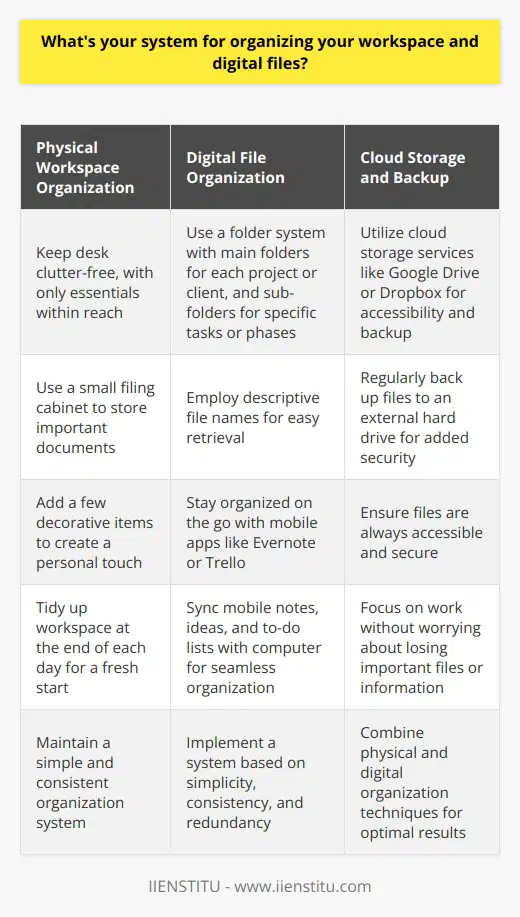
How do you incorporate technology and tools to streamline your workflow?
I am always looking for ways to streamline my workflow and increase efficiency. One of the key ways I do this is by incorporating technology and tools into my daily routine.
Automating Repetitive Tasks
I use automation tools like Zapier and IFTTT to handle repetitive tasks, freeing up my time for more important work. For example, I have a Zap set up that automatically saves email attachments to my Google Drive, so I don't have to manually download and organize them.
Collaboration and Communication
For team collaboration and communication, I rely heavily on Slack and Zoom. Slack allows for quick, easy messaging and file sharing, while Zoom is great for video meetings and screen sharing. These tools help keep everyone on the same page and projects moving forward smoothly.
I'm also a big fan of using project management software like Asana or Trello to keep track of tasks, deadlines, and progress. Having everything laid out visually really helps me stay organized and on top of my work.
Leveraging the Cloud
Whenever possible, I try to use cloud-based tools and storage solutions. This allows me to access my work from anywhere, on any device, and makes collaboration with remote team members a breeze. Google Workspace is my go-to for document creation, spreadsheets, and file storage.
Of course, I'm always on the lookout for new tools and technologies that can help me work smarter, not harder. I enjoy exploring new software and finding ways to integrate it into my workflow to boost my productivity and efficiency.
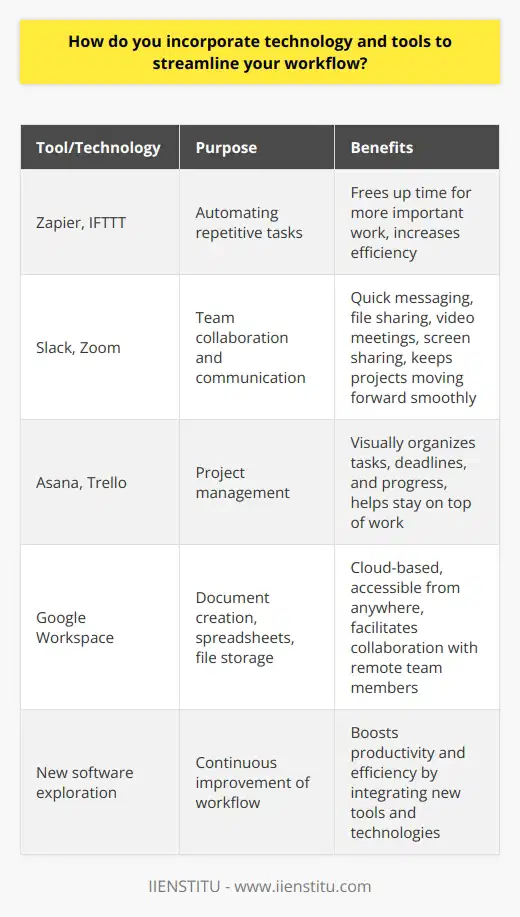
What's your strategy for managing meetings and avoiding unnecessary ones?
When it comes to managing meetings, I have a few key strategies that help me avoid unnecessary ones:
Prioritize and assess the necessity
Before scheduling or accepting a meeting invite, I always ask myself if it's truly necessary. Could the discussion be handled through email or a quick phone call instead? I prioritize meetings that are critical for decision-making, collaboration, or moving projects forward.
Set clear agendas and objectives
I believe that every meeting should have a clear agenda and objectives. This helps keep the discussion focused and ensures that everyone comes prepared. I work with the meeting organizer to define the purpose, desired outcomes, and key talking points beforehand.
Limit attendees to essential participants
To make meetings more efficient, I recommend limiting the attendees to only those who are essential to the discussion. Having too many people can lead to distractions and slow down progress. I identify the key stakeholders and decision-makers needed for each meeting.
Encourage open communication and follow-ups
During meetings, I actively participate and encourage open communication. I share my ideas, ask questions, and listen attentively to others. After the meeting, I ensure that action items and next steps are clearly defined and communicated to all relevant parties. This helps prevent the need for additional meetings to clarify or follow up on decisions.
By being strategic about which meetings I attend, setting clear expectations, and fostering effective communication, I can manage my time efficiently and avoid unnecessary meetings.
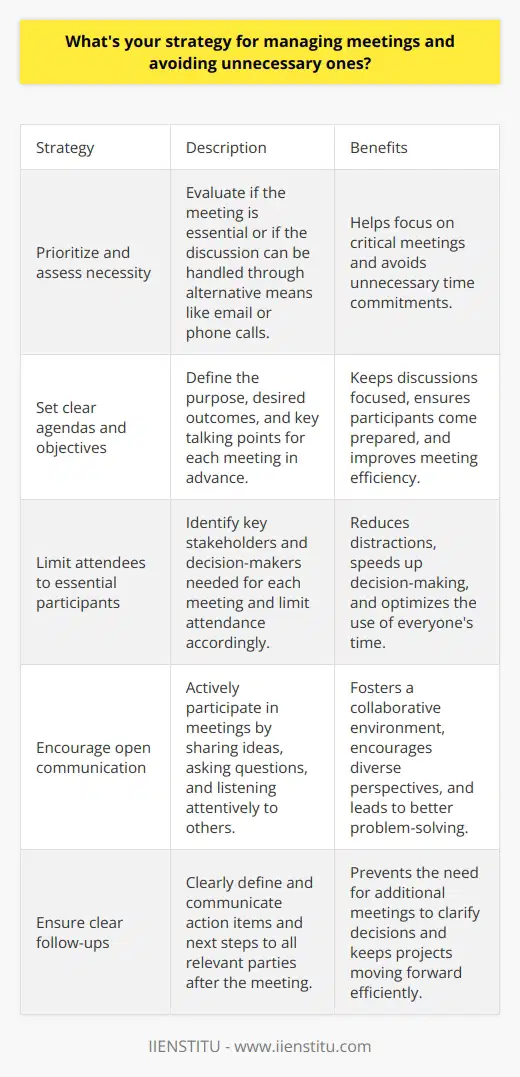
How do you foster a culture of productivity and efficiency in your team?
I foster a culture of productivity and efficiency in my team through several key strategies:
Lead by Example
I believe in setting a strong example for my team. I always strive to be punctual, focused, and dedicated to delivering high-quality work. By demonstrating these qualities myself, I inspire my team members to follow suit.
Set Clear Goals and Expectations
Clear communication is essential for productivity. I work with my team to set well-defined goals and expectations for each project. This ensures everyone understands their roles and responsibilities, minimizing confusion and wasted effort.
Foster Open Communication
I encourage open, honest communication within my team. Regular check-ins, both individually and as a group, help identify any challenges or roadblocks early on. By creating a safe space for sharing ideas and concerns, we can collaborate effectively and find solutions together.
Provide Tools and Resources
Equipping my team with the right tools and resources is crucial for efficiency. Whether it's project management software, communication platforms, or professional development opportunities, I make sure my team has what they need to succeed.
Celebrate Successes
Recognizing and celebrating achievements is a powerful motivator. When my team hits a milestone or delivers exceptional work, I make sure to acknowledge their efforts. This boosts morale and encourages continued productivity.
By implementing these strategies consistently, I've seen firsthand how they contribute to a thriving, efficient team culture.
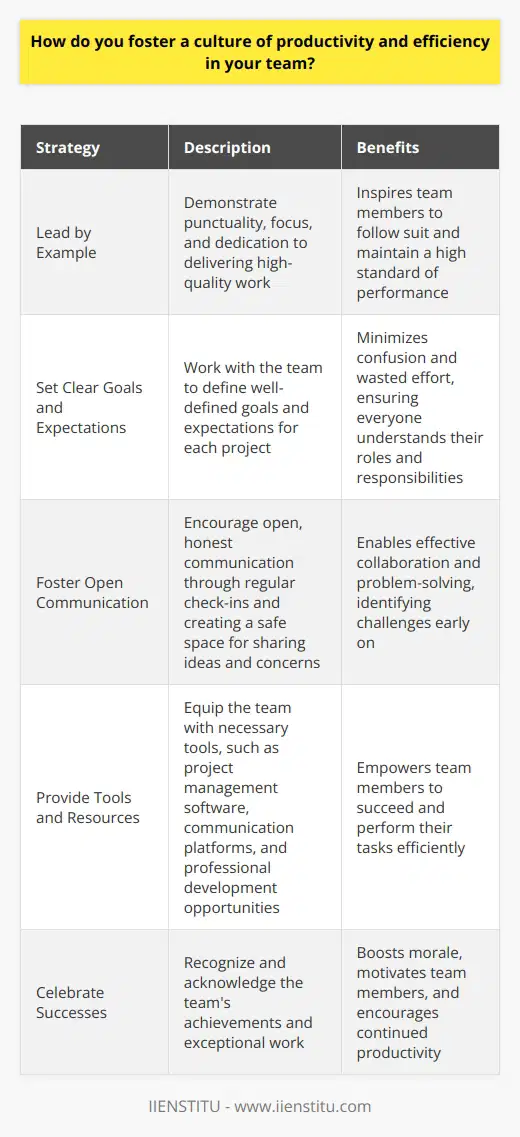
What's your approach to managing your personal and professional networks?
I believe that managing personal and professional networks is crucial for career growth and success. My approach involves actively nurturing relationships, providing value, and maintaining open communication.
Nurturing Relationships
I make a conscious effort to stay connected with my contacts, both personally and professionally. This involves reaching out regularly, whether it's through a quick phone call, an email, or grabbing coffee together. I genuinely care about their well-being and achievements, and I express my support whenever possible.
Providing Value
In my interactions, I always strive to provide value to my network. I share relevant information, insights, or resources that could benefit them in their personal or professional lives. If I come across an interesting article, job opportunity, or event that aligns with their interests, I make sure to pass it along. By consistently offering value, I strengthen the bonds within my network.
Maintaining Open Communication
I believe in the power of open and honest communication. I make myself available to my network, whether they need advice, a listening ear, or a referral. I'm not afraid to ask for help when I need it too. By fostering a culture of open communication, I create a supportive and collaborative environment within my network.
Attending Events and Conferences
I actively seek out opportunities to expand my network by attending industry events, conferences, and workshops. These gatherings provide a platform to connect with like-minded individuals, learn from experts, and exchange ideas. I approach these events with an open mind, ready to engage in meaningful conversations and build new relationships.
Overall, my approach to managing personal and professional networks is rooted in authenticity, generosity, and a genuine desire to connect with others. By nurturing relationships, providing value, maintaining open communication, and actively participating in relevant events, I aim to build a strong and supportive network that contributes to my personal and professional growth.
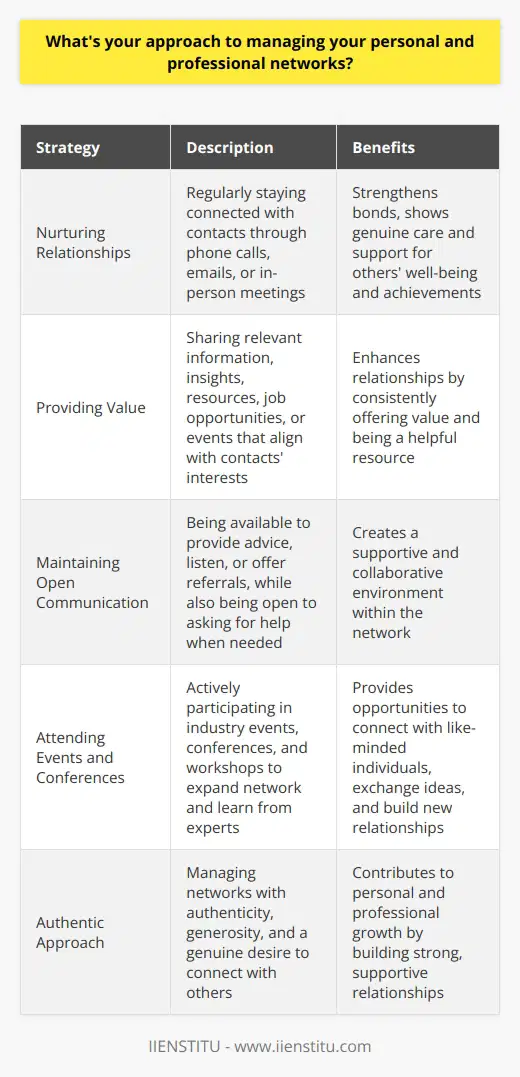
How do you handle decision fatigue and maintain mental clarity?
I handle decision fatigue and maintain mental clarity through a combination of strategies that help me stay focused and energized throughout the day.
Prioritizing Tasks
I start each day by identifying the most important tasks that require my attention. By tackling these first, I can make significant progress before fatigue sets in.
Taking Regular Breaks
I've found that taking short breaks every hour or so helps me recharge and approach decisions with a fresh perspective. During these breaks, I like to stretch, grab a snack, or chat with colleagues.
Practicing Mindfulness
When I feel overwhelmed, I take a few minutes to practice mindfulness techniques like deep breathing or meditation. These help me clear my mind and refocus on the task at hand.
Staying Organized
I keep my workspace tidy and use tools like calendars and to-do lists to stay on top of my responsibilities. Having a clear plan for the day reduces the number of decisions I need to make on the fly.
Overall, I believe that maintaining mental clarity is all about finding the right balance between work and rest. By taking care of myself and staying organized, I can make better decisions and achieve my goals, even on the busiest days.
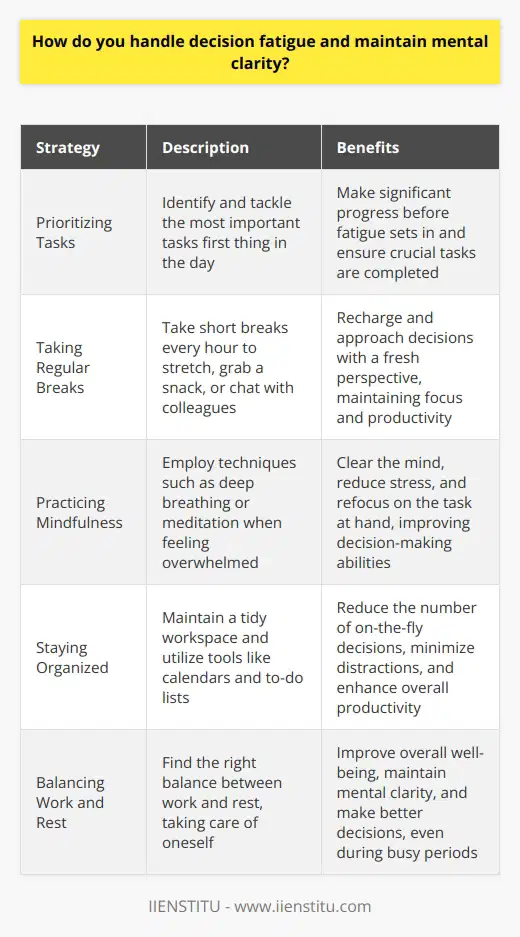
What's your method for setting and achieving realistic goals?
When it comes to setting and achieving realistic goals, I find that breaking them down into smaller, manageable steps is key. I start by clearly defining what I want to achieve and then create a timeline with specific milestones along the way.
Prioritizing and Planning
I prioritize my goals based on their importance and urgency. This helps me focus my energy on what matters most. I also make sure to schedule regular check-ins with myself to assess my progress and make any necessary adjustments to my plan.
Staying Accountable
To stay accountable, I share my goals with a trusted friend or colleague who can offer support and encouragement. I find that having someone to report back to keeps me motivated and on track.
Celebrating Successes
I believe in celebrating my successes along the way, no matter how small they may seem. This helps me maintain a positive outlook and reminds me of how far I've come.
Learning from Setbacks
When setbacks occur, as they inevitably will, I try to view them as learning opportunities rather than failures. I analyze what went wrong and use that knowledge to inform my future efforts.
By following this method, I've been able to achieve some significant goals in my personal and professional life. For example, last year I set a goal to learn a new programming language and was able to do so by dedicating a few hours each week to studying and practicing. It wasn't always easy, but by staying focused and committed, I was able to expand my skill set and take on new challenges at work.
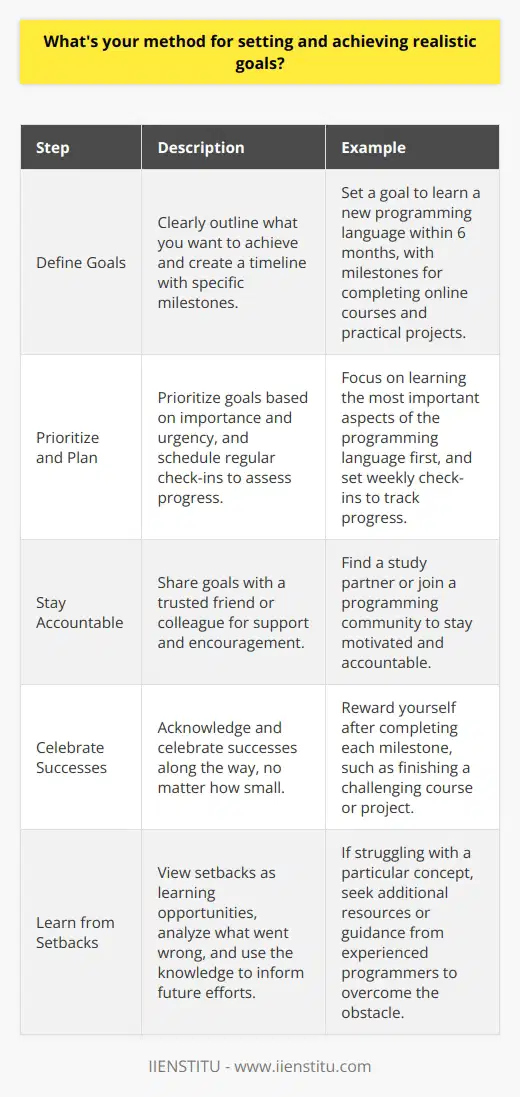
How do you stay updated with the latest time management trends and best practices?
I stay updated with the latest time management trends and best practices in several ways. First and foremost, I regularly read industry blogs and publications to learn about new techniques and strategies. Whenever I come across an interesting article or case study, I make sure to save it for future reference.
Attending Workshops and Webinars
In addition to reading, I also attend workshops and webinars on time management whenever possible. These interactive sessions provide valuable insights from experts in the field and allow me to ask questions and gain practical tips.
Experimenting with New Tools
I'm always eager to experiment with new time management tools and apps. Whether it's a task prioritization matrix or a Pomodoro timer, I enjoy testing out different methods to see what works best for me. Trial and error has helped me refine my personal productivity system over time.
Learning from Colleagues and Mentors
Finally, I believe in the power of learning from others. I often seek advice from colleagues and mentors who have strong time management skills. Their real-world experiences and lessons learned have been invaluable in shaping my own approach to managing my time effectively.
By combining these various learning methods, I strive to continuously improve my time management abilities and stay up-to-date with the latest trends and best practices in the field.
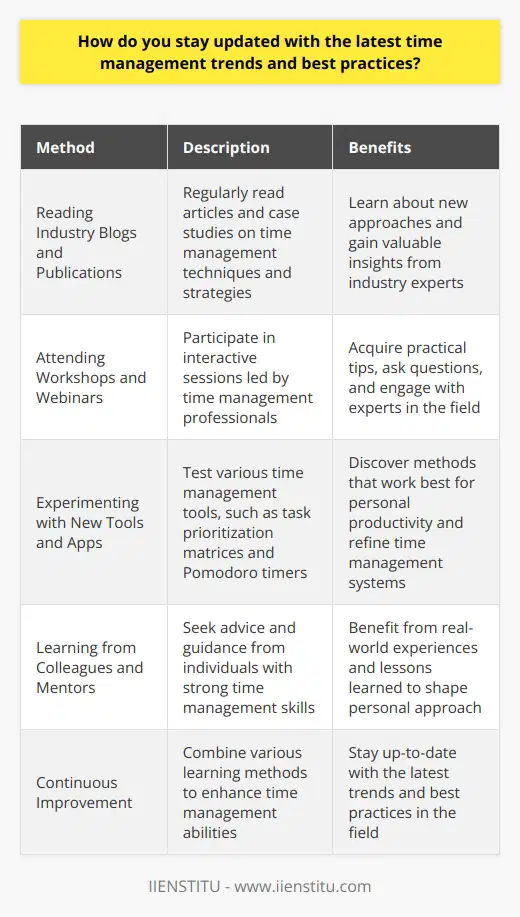
What's your approach to managing your personal brand and online presence?
As a professional in today's digital age, I understand the importance of managing my personal brand and online presence. I take a proactive approach to ensure that my online persona aligns with my values and career goals.
Consistency is Key
I maintain a consistent image and message across all my social media profiles and professional networking platforms. By using the same profile picture, bio, and tone of voice, I create a cohesive and recognizable personal brand.
Sharing Valuable Content
I regularly share content that showcases my expertise, insights, and industry knowledge. Whether it's through blog posts, articles, or social media updates, I aim to provide value to my network and establish myself as a thought leader in my field.
Engaging with My Network
Building relationships is crucial for a strong personal brand. I actively engage with my connections by commenting on their posts, sharing their content, and participating in relevant online discussions. This helps me expand my network and create meaningful connections.
Monitoring and Adapting
I regularly monitor my online presence to ensure that it remains professional and up-to-date. I keep an eye out for any negative or inaccurate information and address it promptly. Additionally, I stay updated with the latest trends and best practices in personal branding to continuously improve my approach.
In my experience, one of the most effective ways to build a strong personal brand is by being authentic and true to myself. I once shared a personal story on LinkedIn about a challenging project I worked on and how I overcame the obstacles. The post resonated with many people, and I received numerous messages from others sharing their own experiences and seeking advice.
Managing my personal brand and online presence is an ongoing process that requires dedication and effort. However, I believe that by staying true to myself, providing value, and actively engaging with my network, I can create a strong and memorable personal brand that will benefit me throughout my career.
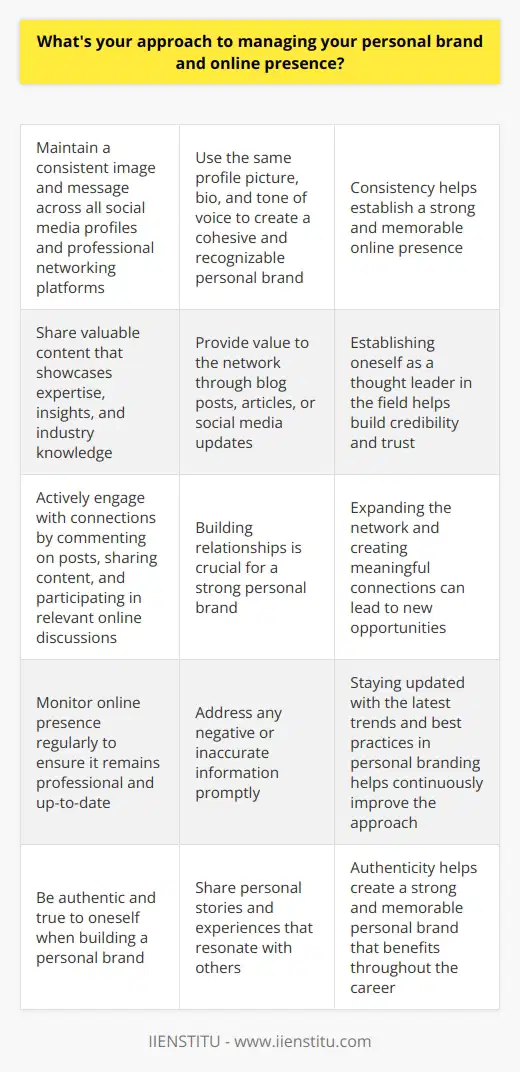
How do you measure and track your productivity over time?
I measure and track my productivity using a combination of methods. Here are a few key strategies I employ:
Set Clear Goals and Objectives
At the beginning of each week, I establish specific, measurable goals aligned with my overall responsibilities. This helps me stay focused and prioritize my tasks effectively.
Utilize Time Tracking Tools
I use time tracking software like Toggl to monitor how much time I spend on different activities. It provides valuable insights into my productivity patterns and helps me identify areas for improvement.
Conduct Regular Self-Assessments
Every Friday afternoon, I review my accomplishments for the week and evaluate my progress against my goals. This self-reflection allows me to celebrate successes, learn from challenges, and make necessary adjustments for the upcoming week.
Seek Feedback from Colleagues and Managers
I proactively seek feedback from my team members and supervisors. Their input helps me gauge my performance, identify blind spots, and continuously improve my productivity.
By combining these strategies, I've been able to consistently meet deadlines, deliver high-quality work, and contribute to my team's success. For example, last quarter, I exceeded my sales targets by 20% while maintaining a 95% customer satisfaction rating.
Tracking productivity is an ongoing process, and I'm always looking for ways to fine-tune my approach. I believe that regular self-reflection, coupled with a willingness to adapt and learn, is key to long-term growth and success.
